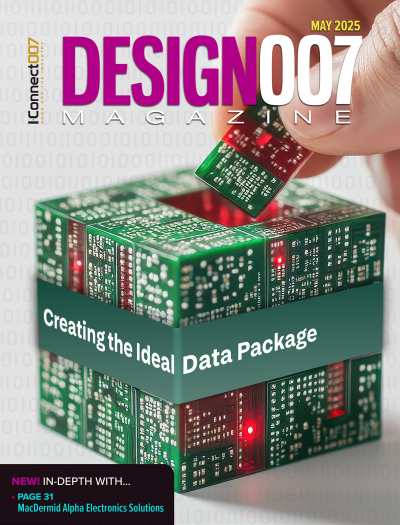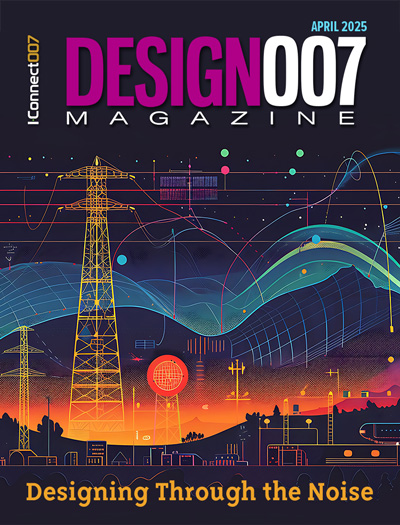-

- News
- Books
Featured Books
- design007 Magazine
Latest Issues
Current Issue
All About That Route
Most designers favor manual routing, but today's interactive autorouters may be changing designers' minds by allowing users more direct control. In this issue, our expert contributors discuss a variety of manual and autorouting strategies.

Creating the Ideal Data Package
Why is it so difficult to create the ideal data package? Many of these simple errors can be alleviated by paying attention to detail—and knowing what issues to look out for. So, this month, our experts weigh in on the best practices for creating the ideal design data package for your design.

Designing Through the Noise
Our experts discuss the constantly evolving world of RF design, including the many tradeoffs, material considerations, and design tips and techniques that designers and design engineers need to know to succeed in this high-frequency realm.
- Articles
- Columns
- Links
- Media kit
||| MENU - design007 Magazine
The Shaughnessy Report: Voices of the Industry
September 6, 2016 | Andy Shaughnessy, PCBDesign007Estimated reading time: 1 minute
It’s good to switch things up. This month, we did just that.
Most issues of The PCB Design Magazine focus on technical challenges that our readers are facing, or will be facing soon. It is a technical magazine, after all. And other times we delve deeper into more high-level problems that can affect your job, such as upcoming legislation or onshoring.
But in the end, this magazine is for you. One day, we editors started thinking, “What if we asked the readers to talk directly to us, and tell us what’s on their mind?”
So, in a survey, we asked readers like you to share some of your thoughts about PCB design, design engineering, and the electronics manufacturing industry in general. We even provided a few helpful “trigger” statements to get your brains firing right, including, “If they would just do this…” and “If I were in charge…” But my favorite has to be “This is really stupid, but we do it all the time…” Haven’t we all made one of these statements at some point in our professional lives?
The result is this issue, Voices of the Industry. This issue is a snapshot of the PCB design community—a look at where we are now, and what challenges and opportunities you all are facing.
Your replies were all over the map. Of course, as journalists, we are drawn to your complaints and challenges—our publications exist to help you address these challenges. And you were not shy about sharing your complaints, that’s for sure! It’s funny to see how designers’ main complaints haven’t changed much in the years that I’ve been covering this segment.
But if this issue is any indication, you all are pretty upbeat about your careers, if not your current company. You may not like everything about your job, but you all seem to really love what you do. And how many people can honestly say they love what they do?
To read this entire article, which appeared in the August 2016 issue of The PCB Design Magazine, click here.
Suggested Items
Facing the Future: Time for Real Talk, Early and Often, Between Design and Fabrication
07/08/2025 | Prashant Patel -- Column: Facing the FutureThere has always been a subtle but significant divide between those who design and those who build printed circuit boards. It’s not a hostile gap, but it is a real one, and in today’s high-speed, high-complexity, high-stakes environment, that gap is costing us more than time and yield. It’s costing us innovation.
DownStream Acquisition Fits Siemens’ ‘Left-Shift’ Model
06/26/2025 | Andy Shaughnessy, I-Connect007I recently spoke to DownStream Technologies founder Joe Clark about the company’s acquisition by Siemens. We were later joined by A.J. Incorvaia, Siemens’ senior VP of electronic board systems. Joe discussed how he, Rick Almeida, and Ken Tepper launched the company in the months after 9/11 and how the acquisition came about. A.J. provides some background on the acquisition and explains why the companies’ tools are complementary.
Elementary Mr. Watson: Retro Routers vs. Modern Boards—The Silent Struggle on Your Screen
06/26/2025 | John Watson -- Column: Elementary, Mr. WatsonThere's a story about a young woman preparing a holiday ham. Before putting it in the pan, she cuts off the ends. When asked why, she shrugs and says, "That's how my mom always did it." She asks her mother, who gives the same answer. Eventually, the question reaches Grandma, who laughs and says, "Oh, I only cut the ends off because my pan was too small." This story is a powerful analogy for how many PCB designers approach routing today.
Connect the Dots: The Future of PCB Design and Manufacturing
07/02/2025 | Matt Stevenson -- Column: Connect the DotsFor some time, I have been discussing the increasing complexity of PCBs and how designers can address the constantly evolving design requirements associated with them. My book, "The Printed Circuit Designer’s Guide to… Designing for Reality," details best practices for creating manufacturable boards in a modern production environment.
Siemens Turbocharges Semiconductor and PCB Design Portfolio with Generative and Agentic AI
06/24/2025 | SiemensAt the 2025 Design Automation Conference, Siemens Digital Industries Software today unveiled its AI-enhanced toolset for the EDA design flow.


